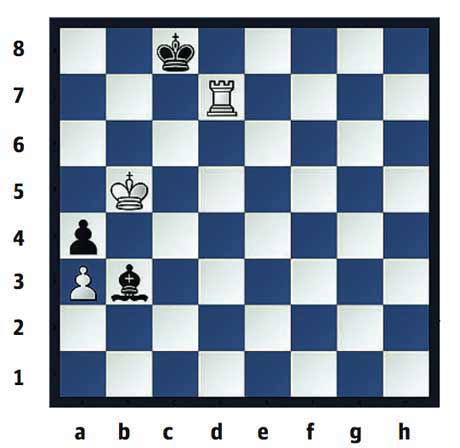- The Guardian, Friday 5 June 2009

Variation from Kasparov-Yusupov, Linares 1996. How can White, to play, win from this position?
RB I've puzzled over the position for half an hour now, and I still can't work out how to do this. Everything I've tried fails. 1 Ra7 - with the idea of the double capture of the pawn and bishop on a4 - runs into the well-known rook's pawn ending: 1...Bc2 2 Rxa4 Bxa4 3 Kxa4 Kb7 and Black's king will sit stolidly in the corner, blocking the pawn's path to promotion. I also looked at king moves, trying to see if there was a way to mate on the back rank, but 1 Kc6 Kb8 ruins that idea. Black's king always slips to the side just before the fatal rook check. So, head bowed with shame, I hand over to Dan.
DK No shame here - this is difficult. In fact, the great Garry also failed to spot the win. Normally, a rook should be superior to a bishop in an ending: the rook's greater mobility allows it to menace enemy pawns more effectively than the monochrome bishop. But here both sides only have a pawn left, and Black's pawn is securely defended by the bishop. In such situations transposing into a king and pawn ending by sacrificing the rook is often successful but, as Ronan points out, with a rook's pawn it's just a draw.
So, we need something special. First let's box in Black's king: 1 Kc6 is actually the winning move. If 1...Kb8, White plays 2 Kb6 - threatening Rd8 mate. Black has only one move, 2...Kc8, and now comes the subtle 3 Rd4 - and this is zugzwang. Black has the perfect defensive position, but he is obliged to move, and then everything falls apart. The king cannot move back to b8 as that allows the back-rank mate, and the bishop has no decent square to land on. 3... Bc2 loses to 4 Rc4+, and any move along the a2-g8 diagonal allows the rook to capture the pawn with an easy win. Alternatively, after 1 Kc6 Black could try 1... Bc2, but 2 Rd4 Bb3 3 Kb6 transposes.





No comments:
Post a Comment